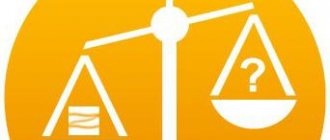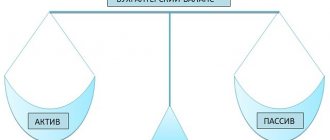Why is it necessary to evaluate balance sheet items?
The preparation of a balance sheet, as well as other reports included in accounting, is subject to a number of specific requirements and rules. Such rules also include a method for assessing the amount that will fall into a specific line of the balance sheet, regardless of whether it is located in its assets or liabilities.
From 2021, financial statements will be submitted exclusively in electronic form. Paper forms will no longer be accepted. We also remind you that in 2021 the reporting forms have been updated.
Knowledge of the rules and methods for valuing balance sheet items helps to correctly formulate all the amounts on the balance sheet lines.
Basic approaches to filling out a balance
In order not to make a mistake in assessing balance sheet items, you must adhere to the following rules (clause 5 of PBU 1/2008 “Accounting Policies of Organizations”, approved by Order of the Ministry of Finance of Russia dated October 6, 2008 No. 106n):
- the company's assets and liabilities should not be mixed - they should be accounted for separately;
- it should be assumed that the company does not intend to cease its activities;
- it is assumed that the adopted accounting policies will be applied consistently in the future;
- transactions are recorded at the time they actually occurred, regardless of the receipt or payment of money associated with them.
Now let's decide on those balance sheet items that need to be assessed. Business operations carried out by the company can affect any accounts: accounting for cash, property, settlements with customers and personnel, with the budget and funds, as well as capital accounts.
Some of the accounts will be reflected in assets (fixed assets, accounts receivable, cash), and some - in liabilities (authorized capital, profit, accounts payable).
When filling out the balance sheet, offsetting between asset and liability items is not allowed; the indicators must be in a net assessment (PBU 4/99 “Accounting statements of an organization”, approved by order of the Ministry of Finance of the Russian Federation dated 07/06/1999 No. 43n) and comparable with the indicators of previous periods.
Let's consider the rules for evaluating the most frequently filled out balance sheet items.
Cheat sheet: Changes in the balance sheet under the influence of business transactions
. Changes in the balance sheet influenced by business transactions. Four types of changes in balance.
The balance sheet is a means of control over the operation of the enterprise as of the 1st day of each month. With the beginning of the next reporting period, many business transactions take place at the enterprise, which in their own way affect the balance sheet. Depending on the nature of changes in balance sheet items, all these business transactions are divided into four groups (types).
1) Active (A+A-).
Operations of the first type
change the composition of property
, i.e. affect only the balance sheet asset. With this type of change, changes occur in the balance sheet asset: one item increases and the other decreases by the same amount. In this case, the balance sheet currency does not change.
For example, if money is received at the cash desk from a current account of 150,000 rubles:
And “Cashier” +150.000
And “Current account” – 150,000,
The asset total remained unchanged.
2) Passive (P+P-).
The second type is characterized by a change in liability items with a constant balance sheet currency. With this change, one liability item increases and the other decreases; the total liability does not change.
For example, part of the profit is used to increase the authorized capital of the organization:
P “Authorized capital” +100.000
P “Profit” –100,000,
The liability total has not changed.
3) Active and passive upwards (A+P+).
The third type causes an increase in the item in both the assets and liabilities of the balance sheet. With this change in the balance sheet, one asset item and one liability item increase by the same amount. The total of assets and liabilities will also change (increase) by the same amount.
For example, a short-term bank loan was received:
A “Current account” +1.000.000
P “Settlements on loans and borrowings (accounts payable” +1,000,000,
Increase in liabilities and assets by 1,000,000.
4) Active and passive in the direction of decrease (A-P-).
With this change in the balance sheet, one asset item decreases and one liability item decreases by the same amount. The total of assets and liabilities will also change (decrease) by the same amount.
For example, funds were transferred from the current account to repay a debt to a supplier of 600,000 rubles:
A “Current account” -600,000
P “Settlements with suppliers (accounts payable” -600,000,
Decrease in liabilities and assets by 600,000.
Accounting accounts, their structure. Accounts active, passive and active-passive
Accounting accounts are a means of control and current reflection of economic assets and their sources. Each account is designed to reflect a specific object of economic assets or sources of their formation. In accounts based on primary accounting documents, current data is accumulated and systematized only on homogeneous business transactions
. The accounts reflect business transactions both in quantitative and monetary terms.
There are two types of accounts: active
and
passive
. The names of the accounts are derived from the sides of the balance sheet (asset and liability).
Active accounts
are intended for accounting of economic assets according to their composition and placement.
Passive accounts
are intended to account for sources of economic funds according to their intended purpose.
The structure of accounts, regardless of their type, is the same - it is a two-sided table, the left side of which is debit
, and the right one is
credit
.
Accounting scheme
| Debit | Credit |
| Initial balance, Сн | |
| Debit turnover, Od | Loan turnover, OK |
| Final balance, Sk |
Account balances at the beginning and end of the month are called balances
.
The amount of business transactions that increases or decreases the amount of business funds or their sources for the reporting month is called turnover
.
The amount of business transactions for the reporting month reflected in the debit of the account is called debit turnover
(or debit turnover).
The amount of business transactions for the reporting month reflected on the credit of the account is called credit turnover
(or loan turnover).
However, with the same structure of accounts, the appointment of parties in active and passive accounts is different.
Active account scheme
| Debit | Credit |
| Initial balance (Сн) - balance (availability) of economic assets at the beginning of the reporting period | |
| Debit turnover (D) - the amount of business transactions that cause an increase in business assets during the reporting period | Loan turnover (Ok) - the amount of business transactions causing a decrease in business assets during the reporting period |
| Final balance (Sk) - the balance of economic assets at the end of the reporting period |
Active accounts have the following features:
1. they reflect the presence and movement of economic assets and property of the enterprise;
2. the opening balance is always a debit balance and shows the availability of funds at the beginning of the reporting period;
3. debit turnover reflects the receipt of funds;
4. loan turnover shows the outflow of funds;
5. The final balance is always a debit balance and shows the balance at the end of the reporting period.
The final balance is calculated using the following formula:
Sk = Sn + Od - Ok
In active
debit accounts reflect an increase, and credit accounts reflect a decrease in the accounting object.
Passive account scheme
| Debit | Credit |
| Initial balance (Сн) - the balance of sources of formation of economic assets at the beginning of the reporting period | |
| Debit turnover (D) - the amount of business transactions that cause a decrease in the sources of formation of economic assets during the reporting period | Loan turnover (Ok) - the amount of business transactions that cause an increase in the sources of formation of economic assets during the reporting period |
| Final balance (Sk) - the balance of sources of economic assets at the end of the reporting period |
Passive accounts have the following features:
1. on passive accounts, records are kept of the sources of formation of the enterprise’s economic assets, i.e. capital and liabilities (debt) of the enterprise;
2. the initial balance is always a credit balance and shows the amount of capital or the presence of liabilities of the enterprise at the beginning of the reporting period;
3. debit turnover shows a decrease in the capital or liabilities of the enterprise;
4. loan turnover shows an increase in the capital or liabilities of the enterprise;
5. The final balance is always a credit balance and shows the amount of capital or liabilities of the enterprise at the end of the reporting period.
The final balance is calculated using the following formula:
Sk = Sn + Ok - Od
For passive
debit accounts reflect a decrease in the accounting object, and credit accounts reflect an increase.
Let's look at how accounting is kept on active accounts using the following example.
Example 1.
Keeping records on active accounts.
At the beginning of the month, the company’s warehouse contained various materials worth 22,000 rubles. During the month, the following business transactions related to the movement of materials were reflected:
| Contents of operation | Amount, rub. |
| 1. Materials received from the founders | 10000 |
| 2. Materials written off for production | 15000 |
| 3. Materials received from suppliers | 42000 |
| 4. Materials received free of charge | 7000 |
| 5. Defective materials were returned to the supplier | 3000 |
| 6. Excess materials sold | 8000 |
Exercise.
Create an active account 10 “Materials”, calculate the turnover of debit, credit and balance at the end of the month.
In the debit of account 10 “Materials” we enter the cost of materials at the beginning of the month (Сн). Next, we post transactions related to the movement of materials into debit and credit. We record the transaction number and amount on the debit side of account 10 if the operation reflects the receipt of materials, or on the credit side of the account if the operation involves a disposal of materials. Then we calculate debit turnover as the sum of all transactions for the receipt of materials and credit turnover as the sum of transactions associated with the disposal of materials. Next, we calculate the ending balance.
Account 10 “Materials”
| Debit | Credit |
| Initial balance - availability of materials in warehouse at the beginning of the month Сн = 22000 | |
| Turnover by debit - receipt of materials to the warehouse 1) 10000 3) 42000 4) 7000 | Loan turnover - disposal of materials from the warehouse 2) 15000 5) 3000 6) 8000 |
| Od = 59,000 | Ok = 26000 |
| Final balance - availability of materials in warehouse at the end of the month Sk = 22000 + 59000 - 26000 = 55000 |
Example 2.
Keeping records on passive accounts.
At the beginning of the month, the company owes the bank for a loan of 80,000 rubles. During the month, the following business transactions related to lending to the enterprise were reflected:
| Contents of operation | Amount, rub. |
| 1. Part of the loan has been repaid | 50000 |
| 2. The loan debt has been fully repaid | 30000 |
| 3. At the end of the month another bank loan was received | 100000 |
Exercise.
Create passive account 66 “Settlements for short-term loans”, calculate turnover and balance.
Account 66 “Settlements on short-term loans”
| Debit | Credit |
| Initial balance - the presence of debt for the loan at the beginning of the month Сн = 80000 | |
| Debit turnover - debt reduction 1) 50000 2) 30000 | Loan turnover - increase in debt 3) 100000 |
| Od= 80000 | Ok = 100000 |
| Final balance - the presence of debt for the loan at the end of the month Sk = 80000 + 100000 - 80000 = 100000 |
Accounts in which the balance can be both debit and credit are called active-passive.
.
Active-passive account scheme
| Debit | Credit |
| Opening balance - the presence of accounts receivable at the beginning of the reporting period | Opening balance - the presence of accounts payable at the beginning of the reporting period |
| Debit turnover : increase in accounts receivable; reduction of accounts payable | Loan turnover : increase in accounts payable; reduction of accounts receivable |
| Final balance - the presence of receivables of the enterprise at the end of the reporting period (when it, the enterprise, is owed) | Final balance - the presence of accounts payable to the company at the end of the reporting period (when it, the company, should) |
If the account balance is both debit and credit, it is called expanded
.
The final balance is called collapsed
.
In the balance sheet for active-passive accounts, the balance is shown expanded, that is, the debit is in the assets of the balance sheet, the credit is in the liabilities.
Methods for valuing balance sheet asset items
- Line 1150 “Fixed assets”
When assessing fixed assets, it is necessary to take into account the requirements of PBU 6/01 “Accounting for fixed assets” (approved by order of the Ministry of Finance of Russia dated March 30, 2001 No. 26n). Fixed assets are reflected in the balance sheet at their residual value. At the same time, assets that meet the criteria of the concept of fixed assets (clause 4 of PBU 6/01) and have a cost of no more than 40,000 rubles per unit can be reflected in the balance sheet as part of inventory (clause 5 of PBU 6/01).
From 2022, FAS 6/2020 “Fixed Assets” and FAS 26/2020 “Capital Investments” are mandatory. PBU 6/01 will no longer be in force. The norms of new standards can begin to be applied earlier, by consolidating the provisions of the standards in the accounting policies of the enterprise.
- Line 1230 “Accounts receivable”
Debts of counterparties in the balance sheet are shown in the amount of total debt (including accrued interest and other sanctions for violation of contract terms). Overdue and unsecured debts must be indicated minus the reserve created according to PBU 21/2008 “Changes in estimated values” (approved by order of the Ministry of Finance of Russia dated October 6, 2008 No. 106n).
- Line 1250 “Cash and cash equivalents”
Using this line, you need to collect all balances on the cash register and current accounts (including foreign currency and special ones).
The first type of balance sheet changes is reflected by the equation
46. Adjustment of a larger amount to a smaller one is carried out in the following way: • “Red reversal”
47. Natural meters represent information about the property of a farm: • Weight • Measure • Count
48. Work in progress is: • Objects of labor being processed at workplaces
49. A norm (standard) in accounting is: • A set of reporting forms
50. The main requirements for accounting are: • Valuation of property in rubles
51. A feature of accounting is the reflection of business processes: • Continuously
52. The reporting period is: • year • quarter • month
53. Valuation is a way of expressing economic phenomena in terms of: • Monetary
54. Primary observation is: • Description of the properties of objects and facts selected to take into account
55. Primary observation is carried out for the purpose of: • Control and analysis of economic activities
56. Primary documents are grouped according to: • Purpose
57. The first type of balance sheet changes is reflected by the equation: • A + X - X = P
58. The first reporting year for an organization registered on October 15, 2010 will be: • the period from October 15, 2010 to December 31, 2011
59. Based on the time of preparation, documents are divided into: • Summary and primary
60. Based on the place of preparation, documents are divided into: • External • Internal
Every day, organizations carry out many business transactions that affect the amount of assets and the sources of their formation. Depending on the method of influencing the balance sheet, all business transactions are usually divided into four types.
The first type includes operations for the receipt of funds to the current account from the cash register or from debtors, the issuance of money from the cash register to accountable persons, the return of unspent amounts by accountable persons to the cash desk, the release of materials from the warehouse to production, the commissioning of fixed assets, the shipment of finished products from the warehouse to customers, etc.
Thus, business transactions of the first type cause changes only in the balance sheet asset; the total balance sheet (currency) does not change.
The first type of balance sheet changes can be represented by the equation
where A is an asset, P is a liability; X - changes in property under the influence of business transactions.
The second type of business transactions is associated with the regrouping of the organization's obligations. For example, taxes are withheld from the wages of the organization’s employees in the amount of 5,000 soms. The operation affected two balance sheet liability items: liabilities under the “Wages payable” item decreased, and under the “Taxes payable” item increased by the same amount, i.e., there was a regrouping of sources in the balance sheet liability.
The second type also includes operations for distribution of profits. Thus, business transactions of the second type lead to changes only in the liabilities side of the balance sheet. The total balance sheet currency does not change.
The second type of balance sheet changes is reflected by the equation
The third type of transaction resulted in an increase by the same amount of one item in the asset balance sheet “Production Materials” and one item in the liability balance sheet “Accounts Payable”. The balance sheet currency increased while maintaining equality between the balance sheet assets and liabilities. Operations of the third type include operations for calculating wages to the organization’s personnel, crediting its accounts, obtaining loans, etc. The third type of balance sheet changes can be reflected by the equation
The fourth type of business transactions is associated with a decrease (disposal) of assets.
As a result of the operation, there was a decrease by the same amount of one item in the asset balance sheet, the item “Cash in the current account,” and one item in the balance sheet liability item, the item “Short-term loans.” The balance sheet currency decreased while maintaining equality between the balance sheet assets and liabilities.
Operations of the fourth type include operations for paying wages to the organization’s personnel, repaying debts to suppliers, the budget, and state extra-budgetary funds.
The fourth type of balance sheet changes can be represented by the equation
Reflecting the state of economic resources at a certain point in time, the balance sheet reveals the structure of assets and the sources of their formation in the context of types and groups, allows you to determine the specific weight of each group, their relationship and interdependence among themselves, serves as a source of information necessary to identify the most important indicators characterizing its financial state. According to the balance sheet, the security of assets, the correctness of their use, the size of material reserves, compliance with financial discipline, profitability of work, etc. are determined.
Signal about shortcomings in work and financial condition; it serves as the basis for identifying their causes. Based on balance sheet data, measures are developed to eliminate them, and the correct use of assets for their intended purpose is monitored. It gives a complete and complete picture not only of the financial state of the enterprise at each moment, but also of the changes that have occurred over a given period of time. The latter is achieved by comparing balance sheets for a number of reporting periods.
Valuation of balance sheet liability items
- Line 1310 “Authorized capital”
This line reflects the amount specified in the constituent documents. If the founder has not fully contributed, his debt must be shown separately on the balance sheet.
- Line 1370 “Retained earnings (uncovered loss)”
If there is no retained earnings from previous years (activities started in the reporting period), only the profit of the reporting year will be reflected in this line - it is given in a net estimate, which is gross profit minus accrued income tax and other payments made from profits (for example, tax sanctions).
- Line 1520 “Accounts payable”
It is filled out if at the reporting date there are debts: to counterparties, the budget or others - in the amount of obligations reflected in the accounting (the numbers will be more reliable if the debt is confirmed by creditors, for example, by issuing reconciliation reports).






